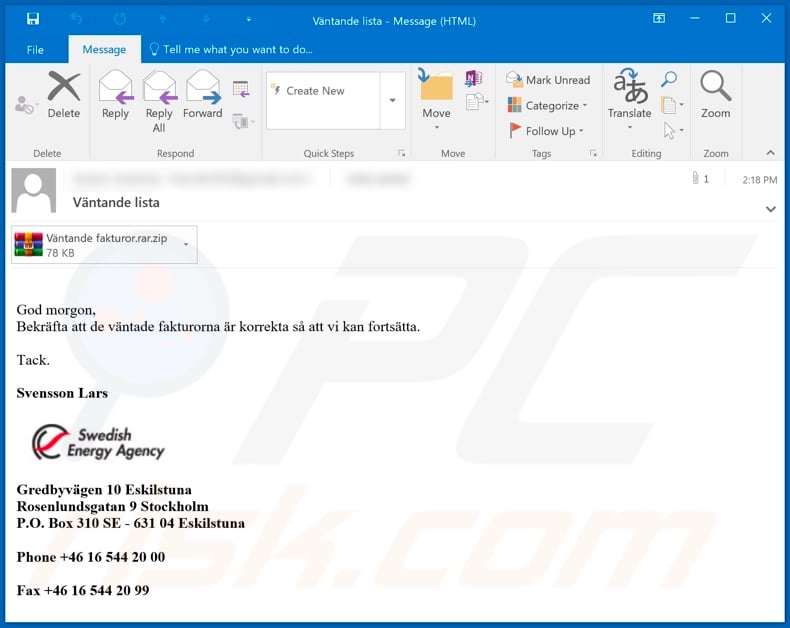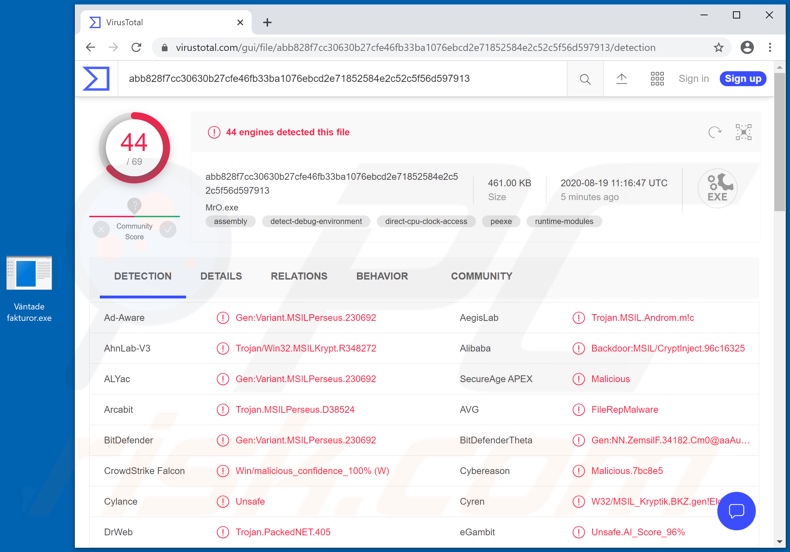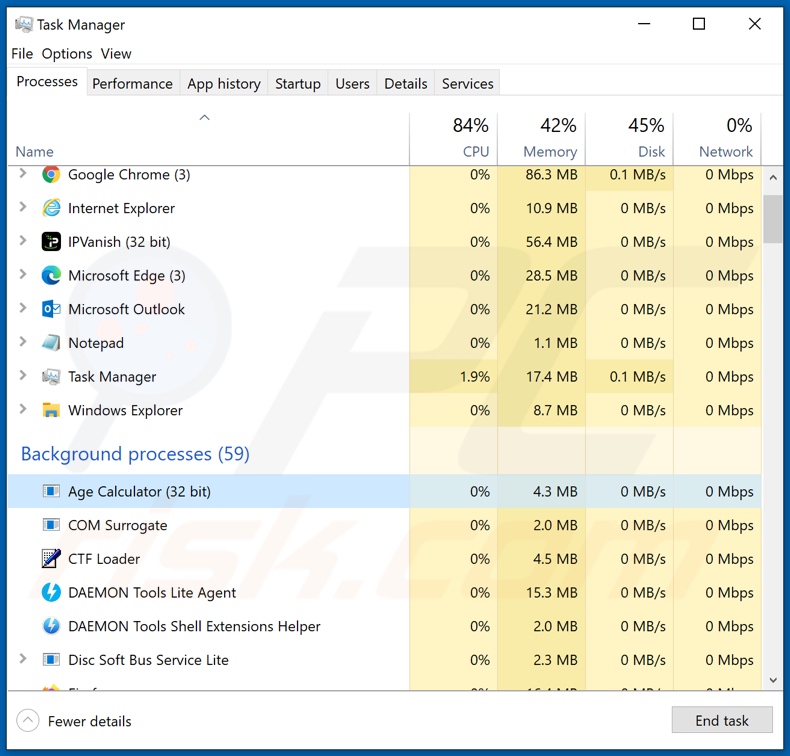Avoid infecting your system via fake "Swedish Energy Agency" emails
Phishing/ScamAlso Known As: Swedish Energy Agency spam
Get free scan and check if your device is infected.
Remove it nowTo use full-featured product, you have to purchase a license for Combo Cleaner. Seven days free trial available. Combo Cleaner is owned and operated by RCS LT, the parent company of PCRisk.com.
What are the fake "Swedish Energy Agency" emails?
"Swedish Energy Agency Email Virus" refers to a spam campaign, which spreads the Agent Tesla RAT (Remote Access Trojan). The term "spam campaign" is used to define a mass-scale operation, during which thousands of deceptive emails are sent. The emails distributed through this spam campaign are disguised as messages from the Swedish Energy Agency.
This agency is a legitimate governmental entity, dealing in sustainable energy systems. Note that these fake emails are in no way connected to the genuine Swedish Energy Agency.

According to a rough translation from Swedish, the "Swedish Energy Agency" scam emails (subject/title "Väntande lista" - this may vary) inform recipients that they must confirm the provided invoices to resume an unspecified process. The fake messages are concluded with genuine details of the legitimate Swedish Energy Agency.
The infectious file ("Väntande fakturor.exe") attached to the emails infects systems with the Agent Tesla RAT upon execution (i.e. opening). Remote Access Trojans are malicious programs with a wide variety of dangerous capabilities, which can be used to facilitate varied misuse of the infected machine.
In general terms, RATs operate by enabling remote access and control over a compromised device. The primary purpose of Agent Tesla is exfiltration of information (i.e. data theft). This malware has keylogging capabilities. Thus, it can record key strokes.
Cyber criminals typically use such features to obtain log-in credentials (i.e. IDs, usernames and passwords) of various accounts. Accounts of interest include (but are not limited to): emails, social networking, social media, messengers, data storage, data sharing, e-commerce, online money transfers, and banking.
To summarize, trusting the fraudulent "Swedish Energy Agency" emails can lead to system infections, financial loss, serious privacy issues and identity theft.
| Name | Swedish Energy Agency spam |
| Threat Type | Trojan, password-stealing virus, banking malware, spyware. |
| Hoax | Emails are disguised as mail from the Swedish Energy Agency. |
| Attachment(s) | Väntande fakturor.exe |
| Detection Names | AVG (FileRepMalware), BitDefender (Gen:Variant.MSILPerseus.230692), ESET-NOD32 (A Variant Of MSIL/Kryptik.XJJ), Kaspersky (HEUR:Trojan.MSIL.Agent.gen), Full List Of Detections (VirusTotal) |
| Symptoms | Trojans are designed to stealthily infiltrate the victim's computer and remain silent, and thus no particular symptoms are clearly visible on an infected machine. |
| Payload | Agent Tesla |
| Distribution methods | Infected email attachments, malicious online advertisements, social engineering, software 'cracks'. |
| Damage | Stolen passwords and banking information, identity theft, the victim's computer added to a botnet. |
| Malware Removal (Windows) |
To eliminate possible malware infections, scan your computer with legitimate antivirus software. Our security researchers recommend using Combo Cleaner. Download Combo CleanerTo use full-featured product, you have to purchase a license for Combo Cleaner. 7 days free trial available. Combo Cleaner is owned and operated by RCS LT, the parent company of PCRisk.com. |
"INPS Email Virus", "COELECSA Email Virus", "Sincere Apologies For This Delay", "Ptt Email Virus" and "Philippine Overseas Employment Administration" are some examples of other malware-proliferating spam campaigns. Scam emails are usually disguised as "official", "important", "urgent", "priority" and similar.
They spread Trojans, ransomware, cryptominers and other malicious programs. These deceptive messages are also used for phishing and other scams. Regardless of what these emails offer, claim, request or demand, their purpose is simply to generate revenue for the scammers/cyber criminals behind them.
Therefore, you are strongly advised to exercise caution with incoming emails.
How did "Swedish Energy Agency Email Virus" infect my computer?
Systems are infected via malicious files distributed in spam campaigns. These files can be attached to the scam emails and/or the messages can contain download links of infectious content. Infectious files can be in various formats, such as executables (.exe, .run, etc.), archives (ZIP, RAR, etc.), Microsoft Office and PDF documents, JavaScript, etc.).
When the files are executed, run or otherwise opened, the infection chain (i.e. download/installation of malware) is initiated. For example, Microsoft Office documents cause infections by executing malicious macro commands. This process is triggered when a document is opened in Microsoft Office versions released before 2010.
Newer versions have "Protected View" mode, which prevents macros from being executed when a document is opened - users are asked to enable macro commands (i.e. to enable editing/content), and thus the infection process can only be triggered if macros are enabled manually.
How to avoid installation of malware
Do not open suspicious or irrelevant emails, especially those received from unknown/suspect senders. Any attachments or links found in dubious messages must not be opened, as they are the origin of potential system infections.
Additionally, you are advised to use Microsoft Office versions released after 2010, however, malicious programs are not proliferated exclusively via spam campaigns - malware is also commonly spread through untrusted download channels (e.g. unofficial and freeware websites, Peer-to-Peer sharing networks and other third party downloaders), illegal activation ("cracking") tools and fake updaters.
Therefore, it is important to only download from official/verified sources and activate/update programs with tools or functions provided by genuine developers. To ensure system health and user safety, it is paramount to have a reputable anti-virus/anti-spyware suite installed and kept up to date.
Furthermore, use this software to run regular system scans and remove detected/potential threats. If you have already opened "Swedish Energy Agency Email Virus" attachment, we recommend running a scan with Combo Cleaner Antivirus for Windows to automatically eliminate infiltrated malware.
Text presented in the fake "Swedish Energy Agency" email message:
Subject: Väntande lista
God morgon,
Benkräfta att de väntade fakturorna är korekta så att vi kan fortsätta.
Svensson Lars
Gredbyvägen 10 Eskilstuna
Rosenlundsgatan 9 Stockholm
P.O. Box 310 SE - 631 04 Eskilstuna
Phone +46 16 544 20 00
Fax +46 16 544 20 99
Screenshot of VirusTotal detections of the malicious attachment ("Väntande fakturor.exe") distributed via "Swedish Energy Agency" spam campaign:

Screenshot of the malicious attachment process in Windows Task Manager ("Age Calculator" - process name may vary):

Instant automatic malware removal:
Manual threat removal might be a lengthy and complicated process that requires advanced IT skills. Combo Cleaner is a professional automatic malware removal tool that is recommended to get rid of malware. Download it by clicking the button below:
DOWNLOAD Combo CleanerBy downloading any software listed on this website you agree to our Privacy Policy and Terms of Use. To use full-featured product, you have to purchase a license for Combo Cleaner. 7 days free trial available. Combo Cleaner is owned and operated by RCS LT, the parent company of PCRisk.com.
Quick menu:
- What is Swedish Energy Agency spam?
- Types of malicious emails.
- How to spot a malicious email?
- What to do if you fell for an email scam?
Types of malicious emails:
![]() Phishing Emails
Phishing Emails
Most commonly, cybercriminals use deceptive emails to trick Internet users into giving away their sensitive private information, for example, login information for various online services, email accounts, or online banking information.
Such attacks are called phishing. In a phishing attack, cybercriminals usually send an email message with some popular service logo (for example, Microsoft, DHL, Amazon, Netflix), create urgency (wrong shipping address, expired password, etc.), and place a link which they hope their potential victims will click on.
After clicking the link presented in such email message, victims are redirected to a fake website that looks identical or extremely similar to the original one. Victims are then asked to enter their password, credit card details, or some other information that gets stolen by cybercriminals.
![]() Emails with Malicious Attachments
Emails with Malicious Attachments
Another popular attack vector is email spam with malicious attachments that infect users' computers with malware. Malicious attachments usually carry trojans that are capable of stealing passwords, banking information, and other sensitive information.
In such attacks, cybercriminals' main goal is to trick their potential victims into opening an infected email attachment. To achieve this goal, email messages usually talk about recently received invoices, faxes, or voice messages.
If a potential victim falls for the lure and opens the attachment, their computers get infected, and cybercriminals can collect a lot of sensitive information.
While it's a more complicated method to steal personal information (spam filters and antivirus programs usually detect such attempts), if successful, cybercriminals can get a much wider array of data and can collect information for a long period of time.
![]() Sextortion Emails
Sextortion Emails
This is a type of phishing. In this case, users receive an email claiming that a cybercriminal could access the webcam of the potential victim and has a video recording of one's masturbation.
To get rid of the video, victims are asked to pay a ransom (usually using Bitcoin or another cryptocurrency). Nevertheless, all of these claims are false - users who receive such emails should ignore and delete them.
How to spot a malicious email?
While cyber criminals try to make their lure emails look trustworthy, here are some things that you should look for when trying to spot a phishing email:
- Check the sender's ("from") email address: Hover your mouse over the "from" address and check if it's legitimate. For example, if you received an email from Microsoft, be sure to check if the email address is @microsoft.com and not something suspicious like @m1crosoft.com, @microsfot.com, @account-security-noreply.com, etc.
- Check for generic greetings: If the greeting in the email is "Dear user", "Dear @youremail.com", "Dear valued customer", this should raise suspiciousness. Most commonly, companies call you by your name. Lack of this information could signal a phishing attempt.
- Check the links in the email: Hover your mouse over the link presented in the email, if the link that appears seems suspicious, don't click it. For example, if you received an email from Microsoft and the link in the email shows that it will go to firebasestorage.googleapis.com/v0... you shouldn't trust it. It's best not to click any links in the emails but to visit the company website that sent you the email in the first place.
- Don't blindly trust email attachments: Most commonly, legitimate companies will ask you to log in to their website and to view any documents there; if you received an email with an attachment, it's a good idea to scan it with an antivirus application. Infected email attachments are a common attack vector used by cybercriminals.
To minimise the risk of opening phishing and malicious emails we recommend using Combo Cleaner Antivirus for Windows.
Example of a spam email:

What to do if you fell for an email scam?
- If you clicked on a link in a phishing email and entered your password - be sure to change your password as soon as possible. Usually, cybercriminals collect stolen credentials and then sell them to other groups that use them for malicious purposes. If you change your password in a timely manner, there's a chance that criminals won't have enough time to do any damage.
- If you entered your credit card information - contact your bank as soon as possible and explain the situation. There's a good chance that you will need to cancel your compromised credit card and get a new one.
- If you see any signs of identity theft - you should immediately contact the Federal Trade Commission. This institution will collect information about your situation and create a personal recovery plan.
- If you opened a malicious attachment - your computer is probably infected, you should scan it with a reputable antivirus application. For this purpose, we recommend using Combo Cleaner Antivirus for Windows.
- Help other Internet users - report phishing emails to Anti-Phishing Working Group, FBI’s Internet Crime Complaint Center, National Fraud Information Center and U.S. Department of Justice.
Share:

Tomas Meskauskas
Expert security researcher, professional malware analyst
I am passionate about computer security and technology. I have an experience of over 10 years working in various companies related to computer technical issue solving and Internet security. I have been working as an author and editor for pcrisk.com since 2010. Follow me on Twitter and LinkedIn to stay informed about the latest online security threats.
PCrisk security portal is brought by a company RCS LT.
Joined forces of security researchers help educate computer users about the latest online security threats. More information about the company RCS LT.
Our malware removal guides are free. However, if you want to support us you can send us a donation.
DonatePCrisk security portal is brought by a company RCS LT.
Joined forces of security researchers help educate computer users about the latest online security threats. More information about the company RCS LT.
Our malware removal guides are free. However, if you want to support us you can send us a donation.
Donate
▼ Show Discussion